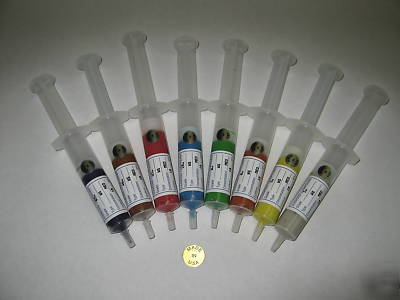Machine Recycling Discussion and Moderated Newsgroup > Components
> Wheels and Bearings
> West
> New
> 18 gram syringe diamond lapping paste compound
18 gram syringe diamond lapping paste compound
Available Diamond Micron Sizes:
1/10,1/8,1/4,1/2,3/4,1,2,3,4,6,9,15,20,25,30,35,40,45,50,60,70,80,90.
Choose any size of any concentration and you choose WS or OS.
Oil-soluble- pastes are good for most applications.
Water-soluble- pastes are good where oil may contaminate the work surface.
All the products are made in the USA!
Diamond Compound Standard Availability
ULTRA FINE Finest finishes on metals and ceramics
SUPER FINE Final Finishing for dies, molds, seals, most applications.
FINE FINISH Preparatory lapping
Lapping and polishing is a process by which material is precisely removed from a work piece (or specimen) to produce a desired dimension, surface finish, or shape. The process of lapping and polishing materials has been applied to a wide range of materials and applications, ranging from metals, glasses, optics, semiconductors, and ceramics. Lapping and polishing techniques are beneficial due to the precision and control with which material can be removed.
There are several techniques used for removing material from a particular work piece: Grinding, lapping and polishing.
Grinding can be defined as the rapid removal of material from a sample either to reduce it to a suitable size or to remove large irregularities from the surface. Range abrasive particle (> 40 m) is typically used.
Lapping is the removal of material to produce a smooth, flat, unpolished surface. Lapping processes are used to produce dimensionally accurate specimens to high tolerances (generally less than 2.5 m uniformity). The lapping plate will rotate at a low speed (<80 rpm) and a mid-range abrasive particle (5-20 m) is typically used. Lapping removes subsurface damage caused by sawing or grinding and produces the required thickness and flatness. The lapping process is less damaging than the grinding.
Polishing is the removal of material to produce a scratch-free, specular surface using fine (<3 m) abrasive particles. Polishing is typically done at very low speeds.

